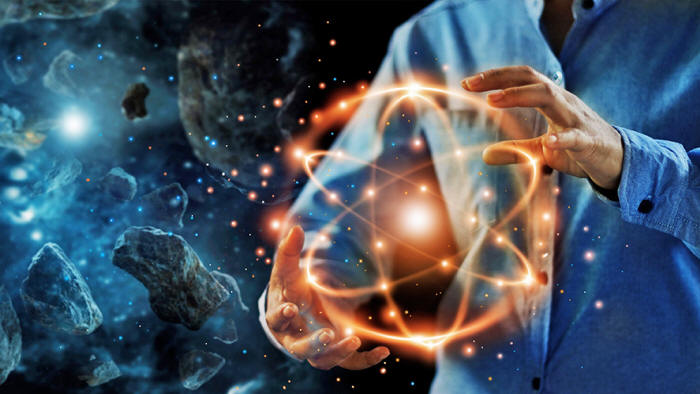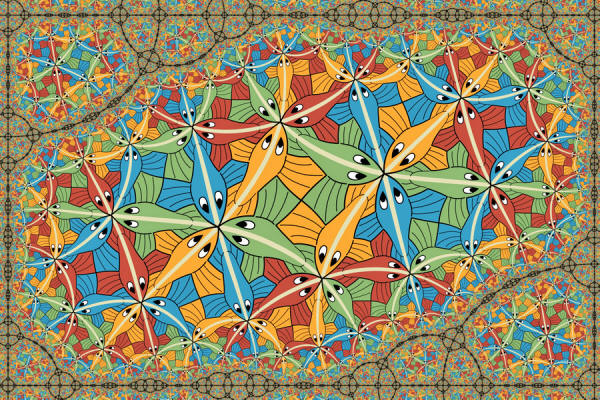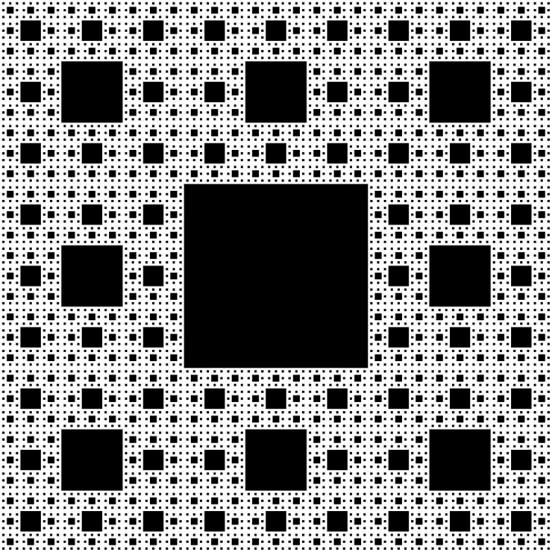|
July-November 2021 from BigThink Website
returns to Penrose and Hameroff's theory of "quantum consciousness"...
In the 1990s, long before winning the 2020 Nobel Prize in Physics for his prediction of black holes, physicist Roger Penrose teamed up with anesthesiologist Stuart Hameroff to propose an ambitious answer.
They claimed that the brain's neuronal system forms an intricate network and that the consciousness this produces should obey the rules of quantum mechanics - the theory that determines how tiny particles like electrons move around. This, they argue, could explain the mysterious complexity of human consciousness.
Penrose and Hameroff were met with incredulity. Quantum mechanical laws are usually only found to apply at very low temperatures.
Quantum computers, for example, currently operate at around -272°C. At higher temperatures, classical mechanics takes over. Since our body works at room temperature, you would expect it to be governed by the classical laws of physics.
For this reason, the quantum consciousness theory has been dismissed outright by many scientists - though others are persuaded supporters.
Instead of entering into this debate, I decided to join forces with colleagues from China, led by Professor Xian-Min Jin at Shanghai Jiaotong University, to test some of the principles underpinning the quantum theory of consciousness.
In our new paper, we've investigated how quantum particles could move in a complex structure like the brain - but in a lab setting.
If our findings can one day be compared with activity measured in the brain, we may come one step closer to validating or dismissing Penrose and Hameroff's controversial theory.
Brains and fractals
Our brains are composed of cells called neurons, and their combined activity is believed to generate consciousness...
Each neuron contains microtubules, which transport substances to different parts of the cell.
The Penrose-Hameroff theory of quantum consciousness argues that microtubules are structured in a fractal pattern which would enable quantum processes to occur.
Fractals are structures that are neither two-dimensional nor three-dimensional, but are instead some fractional value in between.
In mathematics, fractals emerge as beautiful patterns that repeat themselves infinitely, generating what is seemingly impossible: a structure that has a finite area, but an infinite perimeter.
This might sound impossible to visualize, but fractals actually occur frequently in nature.
If you look closely at the florets of a cauliflower or the branches of a fern, you'll see that they're both made up of the same basic shape repeating itself over and over again, but at smaller and smaller scales.
That's a key characteristic of fractals.
The same happens if you look inside your own body:
Fractals also feature in the enchanting repeating artworks of M.C. Escher and Jackson Pollock, and they've been used for decades in technology, such as in the design of antennas.
These are all examples of classical fractals - fractals that abide by the laws of classical physics rather than quantum physics.
This extension of Escher's Circle Limit III shows its fractal, repeating nature. (Vladimir-Bulatov/Deviantart, CC BY-NC-SA)
It's easy to see why fractals have been used to explain the complexity of human consciousness.
Because they're infinitely intricate, allowing complexity to emerge from simple repeated patterns, they could be the structures that support the mysterious depths of our minds.
But if this is the case, it could only be happening on the quantum level, with tiny particles moving in fractal patterns within the brain's neurons.
That's why Penrose and Hameroff's proposal is called,
Quantum consciousness
We're not yet able to measure the behavior of quantum fractals in the brain - if they exist at all.
But advanced technology means we can now measure quantum fractals in the lab. In recent research involving a scanning tunneling microscope (STM), my colleagues at Utrecht and I carefully arranged electrons in a fractal pattern, creating a quantum fractal.
When we then measured the wave function of the electrons, which describes their quantum state, we found that they too lived at the fractal dimension dictated by the physical pattern we'd made.
In this case, the pattern we used on the quantum scale was the Sierpiński triangle, which is a shape that's somewhere between one-dimensional and two-dimensional.
This was an exciting finding, but STM techniques cannot probe how quantum particles move - which would tell us more about how quantum processes might occur in the brain.
So in our latest research, my colleagues at Shanghai Jiaotong University and I went one step further.
Using state-of-the-art photonics experiments, we were able to reveal the quantum motion that takes place within fractals in unprecedented detail.
And in each of these structures we conducted hundreds of experiments.
We also conducted experiments on a square-shaped fractal called the Sierpiński carpet. (Johannes Rössel/wikimedia)
Our observations from these experiments reveal that quantum fractals actually behave in a different way to classical ones.
Specifically, we found that the spread of light across a fractal is governed by different laws in the quantum case compared to the classical case.
This new knowledge of quantum fractals could provide the foundations for scientists to experimentally test the theory of quantum consciousness.
If quantum measurements are one day taken from the human brain, they could be compared against our results to definitely decide whether consciousness is a classical or a quantum phenomenon.
Our work could also have profound implications across scientific fields.
By investigating quantum transport in our artificially designed fractal structures, we may have taken the first tiny steps towards the unification of physics, mathematics and biology, which could greatly enrich our understanding of the world around us as well as the world that exists in our heads.
There is nothing better than mixing two great mysteries to produce an even bigger one...
Granted, there are many ways to go about exploring this question, and science is not the only one. Artists and philosophers most deservedly hold a claim to elucidating some aspects of our identity and subjective life.
In a sense, science is
the new kid on the block, given that we can date the first "almost"
scientific musings about mind and matter to the early 17th century
with Descartes. Well beyond Descartes and his mind-body duality, new questions have emerged that are as exciting as they are nebulous:
There is nothing better than mixing two great mysteries to produce an even bigger one.
The truth is that despite the tremendous success of quantum physics when it comes to its applications - the digital and nuclear technologies that define much of modern life - its interpretation remains uncertain, a target of heated debate among physicists.
We know how to use quantum physics, but we do not know what it is telling us about the nature of reality.
The brain is a black box
As for how the brain sustains our mind and consciousness, we still know precious little, even if advances in imaging techniques in the past two decades or so have revealed, to a certain extent, how clusters of neurons, often in different regions in the brain, ignite under different stimuli like lights on a Christmas tree.
In a nutshell, the issue here is that tagging neuronal activity is the easy part of the task.
The hard part is understanding how active neurons conspire to create the sense of who we are - that is, translating bioelectrical activity and blood flow into self-awareness.
In the 17th century, Descartes proposed to split mind and matter:
Mind is not matter but, in ways that stumped even Descartes, can influence matter.
Descartes also postulated that mind precedes matter, the essence of his famous,
This mind-body dualism caused and causes much confusion, especially for those who use it to defend the existence of some kind of soul or spirit that is independent of matter and that can survive its inexorable decay.
How does the "I" that is you persist without the grounding structures of the material brain?
Largely, scientists and philosophers defend that only matter exists. The fact that the workings of the brain remain mysterious is not due to some immaterial entity but to our own difficulty of understanding its complexity.
There are those who propose that to understand the brain, we must start bottom-up: from individual neurons to synaptic links and the neurotransmitters that flow between them to clusters of neurons and brain circuits.
There are those, especially the philosophers,
...sometimes known as the "Mysterians," who defend that we are cognitively incapable of (or, as McGinn puts it, "cognitively closed" to) understanding consciousness - that is, the subjective experience we have when we are feeling something, be it the tone of a color or falling in love.
Can quantum mechanics explain consciousness?
The bizarre behavior of quantum systems inspires speculation on how they may play a role in the workings of the brain.
After all, if we take a bottom-up approach, the brain is made of neurons; and neurons, like any other cell, need proteins and a host of biomolecules to function.
Since quantum effects take place at the molecular level, it is possible that they may do something important for consciousness.
The first quantum effect that may be relevant is superposition,
For example, before an electron is detected, it can be in many places at once - or at least that is how we interpret the data.
The mathematical machinery of quantum mechanics allows us to compute the probability that the electron will be found here or there once measured.
The data, then, are the measurements of the electron's position within the accuracy of the measuring device.
This is what Nobel Prize laureate physicist Roger Penrose and anesthesiologist Stuart Hameroff have proposed.
Below is a very instructive video of their view:
The microtubules could be a sort of quantum highway network supporting the superposition and entangled states of tubulin inside neurons.
They supposedly act as a quantum computer to optimize neuronal and inter-neuronal performance. Other ideas come from Giulio Tononi and Christoph Koch's Integrated Information Theory, which they claim applies to quantum vibrations in microtubules.
The second quantum effect that might be relevant is entanglement,
We say that entangled states behave as a single entity, losing their individual identities.
The idea here is to use the spatial aspect of entangled states to "spread out" quantum effects with a given signature across long distances within the neuronal networks.
Cold water for quantum consciousness
There has been strong criticism of Penrose and Hameroff's ideas from experimental and theoretical angles.
Theoretical arguments, for example presented by MIT physicist Max Tegmark, suggest that the brain is too busy and warm an environment to sustain coherent quantum states.
Indeed, coherent quantum states are very fragile:
In effect, the warm brain environment can turn quantum mechanics into classical physics.
There is no question that quantum effects add a degree of bafflement to our understanding of the world.
It is also true that, at least at the synaptic level where a host of neurotransmitters flow through narrow acceptance gates, quantum effects may indeed play a role.
Currently, the majority opinion points toward a classical explanation for the workings of the brain through the myriad couplings of neuronal clusters and their incessant firings.
Given the complex nature of inter-neuronal connectivity, there is certainly room for exploration and speculation. As is often the case, the solution may be not "either-or" but "both."
There may be cooperation between quantum and classical effects that jointly determine the functioning of the brain at different levels.
This unknowability may well be what will rescue what is left of our humanity from the unstoppable mechanization and objectification of modern existence...
|






